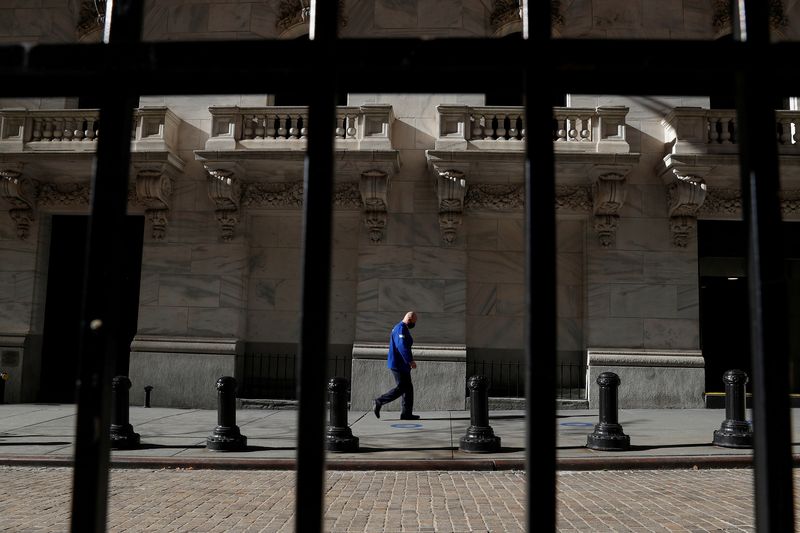By David Randall and Lewis Krauskopf
NEW YORK (Reuters) - Worries over the banking crisis are boosting disparate assets, with traditional safe-havens such as gold, Treasuries and money markets seeing high demand along with more speculative instruments such as tech stocks and bitcoin.
The unusual cross-currents come as the financial distress that started earlier this month with the collapse of California's Silicon Valley Bank has spread to Europe, with investors on edge about the health of the financial system even after UBS Group agreed to buy ailing Credit Suisse (SIX:CSGN) in a state-backed takeover and major central banks took steps to reassure markets.
The troubles in the financial sector have sparked rapid repositioning in asset markets, as investors bet the Federal Reserve and other central banks will have to slow interest rate hikes in order to avoid hurting the economy as the banking woes threaten to slow growth.
As a result, some assets that typically struggle when central banks are expected to tighten monetary policy are now holding strong: The S&P 500 tech sector is up around 2% since March 8, the day Silicon Valley Bank's troubles became apparent, compared with a 1% decline in the broad S&P 500 index. Bitcoin, which fell 60% as rates were rising in 2022, has gained nearly 30% since March 8.
The gains have come alongside big moves in assets traditionally perceived as safe-havens during uncertain times. Yields on shorter-dated Treasuries, which move inversely to prices, saw a historic drop last week, while money market funds notched their biggest inflows since April 2020 in the week to March 15, Refinitiv Lipper data showed. Gold prices are up more than 9% while the S&P 500 utilities sector has gained 2.2%.
But assets seen as sensitive to economic growth have struggled. Oil prices have fallen to their lowest level since 2021, and shares of industrial and small-cap companies have also faltered.
"I'm not surprised that we're getting confusing signals because this is a very confusing moment," said Christopher Smart, chief global strategist at Barings. "Investors are very unsure about what comes next."
(GRAPHIC: Market fallout of a banking crisis- https://www.reuters.com/graphics/USA-STOCKS/INVESTORS/zdvxdqnkavx/chart.png)
Looming over the market gyrations is the Fed’s two-day policy meeting that concludes on Wednesday. Earlier this month, investors were bracing for a hefty 50 basis-point rate hike as the central bank continued to stress the need to raise rates to tame inflation. But markets on Monday were pricing in a roughly 75% chance of a 25-basis-point rate increase and a 25% chance that the Fed pauses on its most aggressive rate hiking cycle since the early 1980s, even though inflation remains far above its target.
Some investors see the continued gains in riskier segments of the stock market as a sign that more volatility lies ahead - especially if forecasts of a recession come to pass.
"The fact that the Nasdaq has held up better tells me that there’s another shoe to drop,” said Phil Orlando, chief equity market strategist at Federated Hermes, who has been moving into defensive sectors, cash and bonds in anticipation of the S&P 500's testing its bear market lows from October. “If earnings are going to come down by at least another 10%," he said, "it’s hard to make the case" for an expansion in price/earnings multiples.
Morgan Stanley (NYSE:MS) strategist Michael Wilson put forward a similarly cautious view, recommending that investors stay away from tech shares and go with defensive names in anticipation of heightened volatility.
“The events of the past week mean that credit availability is decreasing for a wide swath of the economy, which may be the catalyst that finally convinces market participants that earnings estimates are too high,” he wrote in a Monday report.
Of course, the decline in Treasury yields has bolstered areas of the market like tech stocks - whose recent strength has outweighed declines in banking and energy shares to help support the broader S&P 500.
“Less than two weeks ago, the main challenge for the stock market was higher rates. Well, the 10-year U.S. Treasury yield is down about 60 basis points from early March,” said Keith Lerner, chief market strategist at Truist Advisory Services, in a Monday report. Nevertheless, he cautioned that banking woes are likely to tighten lending and weigh on growth.

Investors will likely continue moving to money markets and other cash instruments until the tumult in U.S. regional banks subsides, said Liz Ann Sonders, chief investment strategist at Charles Schwab (NYSE:SCHW).
"The bigger picture story here is that the era of easy money is over and ... things are coming home to roost,” she said.